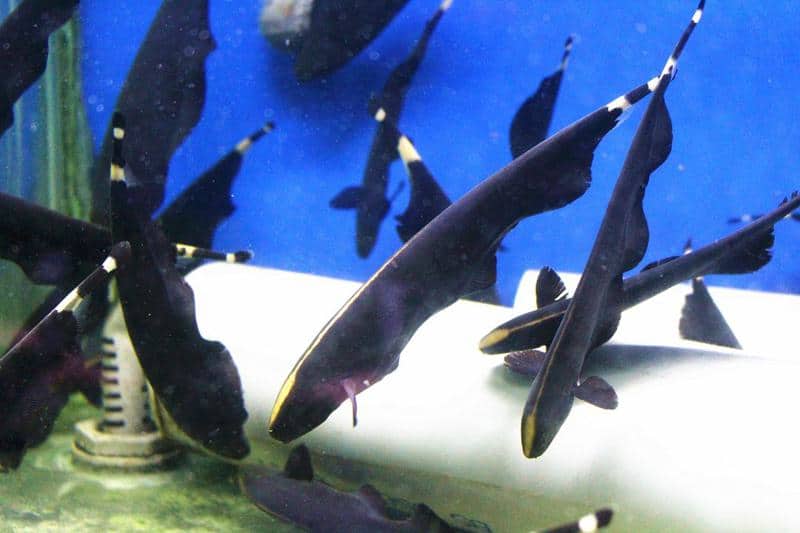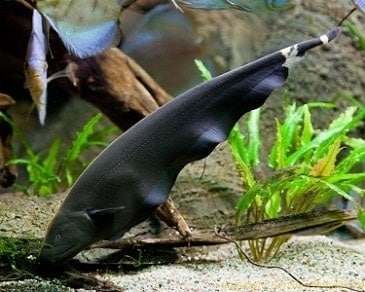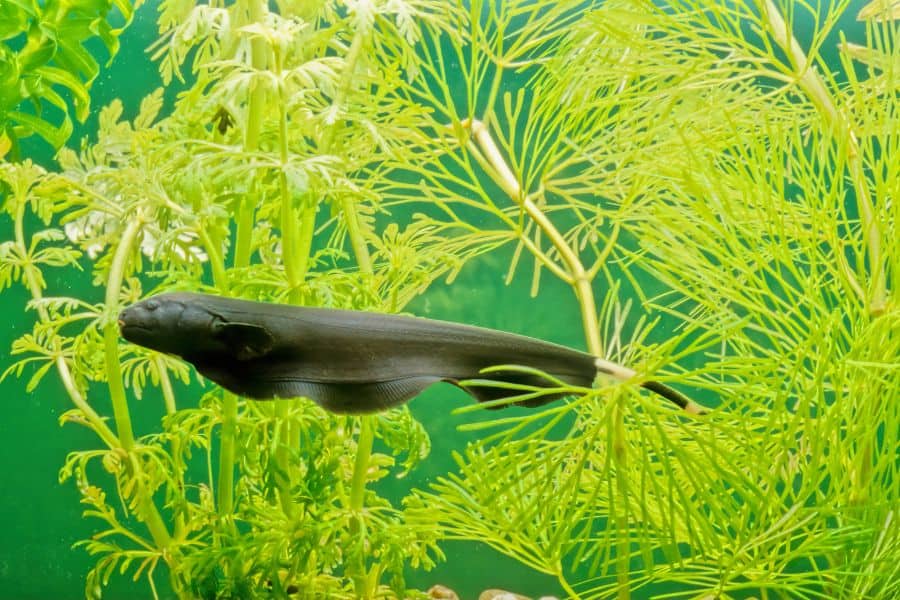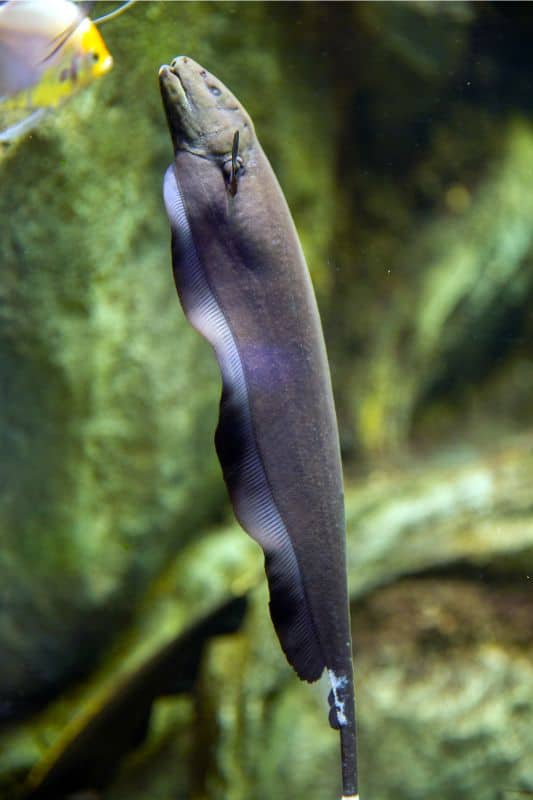The enigmatic beauty of the black ghost knife starts from the two white rings on its tail and goes to its exciting wave-like motion. Due to the lack of a dorsal and caudal fin, the black ghost knife showcases a rare swimming capability guaranteed to start a conversation with your visitors.
Despite the monochromatic color scheme of the rest of its body, this tropical fish has become popular among many hobbyists. This is because the black ghost knife has some of the most exciting features you could ever see in freshwater fish, particularly an electric system that acts as a sixth sense.
As much fun as it is to own one of these fish, it is important to note that they can be challenging to take care of. Their huge 18+ inch bodies require lots of care, including bigger tanks, food, special tank mates, etc. Also, its distinctive features mean you will need to go the extra mile for it to thrive.
In this complete black ghost knife care guide, you will learn the fish’s origins, behaviors, temperament, environmental needs, appearance, and bodily functions, and much more.
Read on to learn of the best practices and precautions to take to ensure your black ghost knife lives for more than 10 years.
Black Ghost Knife Overview
| Names | Black ghost knife fish or Black ghost knife fish
Also known as the Apteronotid eel, black knife, or just black ghost. |
| Scientific Name | Apteronotus albifrons |
| Origins and Reginal Distribution | Originated from tropical waters of South America in regions like the Amazon Basin, Paragua-Parana River, and Venezuela. |
| Tank Size | 100 gallons minimum for one black ghost
300 gallons minimum for a group (less than 3 black ghost knife) |
| Water Hardness Conditions | 0 – 10 KH |
| Ideal Tank Mates | Less aggressive, equal-sized fish. |
| Average Size | Up to 20 inches |
| Colors | A monochromatic black color with two white rings on the tail |
| Average Lifespan | Typically, 10 years can live up to 15 years in the most ideal conditions |
| Lighting Conditions | Medium to lower light levels |
| Diet | Primarily carnivorous |
| Optimal pH levels | 6.8 – 7.8 |
| Optimal Temperature | 75 – 85 degrees Fahrenheit |
Originating and distributed in the South American basins, the black ghost can be found in fast-moving waters of several regions, including Venezuela, Columbia, Argentina, Guianas, Panama, and Paraguay.
Their habitats consist of freshwater regions in deep depths of the river at about 16 feet. Due to this, they live amongst dense aquatic vegetation and have to navigate through tiny spaces between trees and rocks. Having slender bodies makes these environments ideal for them.
You would think that the black ghost knife gets its name from its odd and quirky appearance. After all, it can be spooky to some, hence, the name ghost. However, this is not the case.
They get the name ‘ghost’ because the tribes of Amazon believed they were vessels holding the ghosts of the departed. It is named the ‘black knife’ due to its black monochromatic color and its shape-similarity to a knife.
Ghost knife belongs to the ghost knife fish family (Apteronotidae). This is a family of ray-finned fishes, all native to South America. All are nocturnal and feature small eyes, with a few exhibiting sexual dimorphism.
Black ghost knife fishes belong to the Apteronotus genus, known for having weakly electric knifefish. They feed on small animals, but they often take to frozen foods when raised and bred in aquariums.
The closest sibling to the black ghost (Apteronotus albifrons) is the brown ghost knifefish (Apteronotus leptorhynchus), known for its brown monochromatic coloration with similar rings on its tail.
Black Ghost Knife Lifespan
Ghost knifefish is a relatively hardy fish with a lifespan of about 10 years and the capability to live up to a ripe 15 years of age.
How long the fish lives depends on a lot of factors, including water conditions, feeding habits, habitat, water parameters, and much more. The age might vary depending on the habitat, the wild being the most ideal condition for such species.
Appearance
The big ghost knife’s wavy, flowing, and somewhat dancing swimming style is probably the first thing you will notice about the fish. This gorgeously enchanting motion is created by the fact that the ghost knife lacks a dorsal and caudal fin.
Features, Anatomy, Colors, Types
Its skinny body does not show any sign of caudal fins on the tail or even a protruding small dorsal fin at the top. Instead, the ghost knife only has the anal and pectoral fins, which are its primary ways of moving about.
The pectoral fin is paired with an extended anal fin to make a longer uniform fin on the underside; this is what creates the unique morphology of wave-like flowing motion when the fish swims about.
This uniform wave and rippling effect ensure the fish can swim bidirectionally in any direction, meaning the fish can also swim backward or forward in the same motion.
The strange anatomy follows a knife-like shape that starts with the tail (with two white rings) that looks like a knife handle. The curved shape from the start of the tail to the head looks like the sharp edge of a knife, hence the “black knife.”
Another extraordinary aspect of the black knife is that it can generate electricity using spinal cord neurons.
It is important not to mistake the electricity in these fish for that in electric eels. Unlike electric eels, the electrical pulses in ghost knife fish are weak. This is because its purpose is to act as a sixth sense, a feature it shares with other types of ghost knifefish.
Since ghost knifefish live in murky waters in deep depths, seeing can become a problem. Their small eyes cannot aid them visually, and that is where the electrical systems come in.
Like echolocation in bats, ghost knifefish utilizes active electrolocation by using electric fields to navigate. The electric fields also help in communicating via the processes of electrogenesis and electroreception.
Each ghost knifefish has electric receptors that can sense electric organ discharges (EODs) from other fish. This helps them communicate and is a handy tool in breeding by assisting females in identifying potential mates for reproduction.
Size
Black ghost knife has an average size of about 14 – 18 inches. However, it can grow up to 20 inches in the best environment.
You won’t find any ghost knife below 18 inches. The fish are resilient, and if you do not properly plan for their huge size when they grow up, then you may lose them.
Black Ghost Knife Fish Behavior & Temperament

As nocturnal animals, the fish swim and eat mostly at night. Serving them food before bed is a good practice to ensure they are not malnutritional.
Many assume that with their big sizes and spooky looks then, the ghost knife fish must be aggressive; this is not true.
They are peaceful fish that do not disturb other tank mates. However, they are territorial, and you can expect them to show some form of aggression when they have to compete for resources with another black ghost knife fish.
Meaning you will rarely see the black ghost act out in any way if you house it in a well-spaced tank with compatible tank mates, enough food, and optimal water conditions.
Black Ghost Knife Fish Care
Below is the complete care guide you need to ensure your ghost knife has a long and healthy life:
Tank Size & Environment
Aquarists should only keep the ghost fish in tanks that can hold a minimum of 100 gallons, ideally 150. Anything less than that will lead to stress, aggression, and diseases or a much shorter lifespan in extreme cases.
If you so choose to keep the fish with one or two of its kind, then aim for about 100 gallons more for each fish. Therefore, you will need a 300-gallon tank to host at most three black ghost knife fish.
Due to this large aquarium demand, you often only see the black knife in aquarium exhibits at parks and recreation centers.
Low lighting with lots of hiding space is also best. Include caves, driftwood, aquarium plants, tunnels, and rocks to simulate their natural habitat and give them a fun playground to enjoy living in.
As bottom dwellers, you will also need a soft substrate like fine sand. Rocky and rough substrates can easily injure their bodies.
Tank Mates
So, can black ghost knife fish live with goldfish? Or any other common aquarium fish.
As a rule of thumb, it is always best to keep black knife fish with peaceful same-size fish. A goldfish can live with a ghost knife since they are non-aggressive toward one another unless they compete for resources.
If you have enough space, a befitting environment for both species and enough nutrition, then you can raise the ghost knife with many similar-sized peaceful fish. Avoid aggressive fish in the tank at all costs.
One thing to note is that you shouldn’t place two knife fish in the same tank. Two black ghost knife fish can live together peacefully, but you have to ensure they never have a reason to be territorial. This will require a tank of at least 300 gallons big and enough food and care.
Some of the best tank mates for ghost knives include:
- Other ghost knife fish
- Peaceful catfish
- Angelfish
- Non-aggressive cichlids
- Plecos
- Green neon tetras
- Ciry catfish
- Rope fish
- Oscars
Water Conditions
If you were to cause harm to the black knife fish, then there is a good chance it has something to do with poor water conditions.
Apart from their large sizes, taking care of the black ghost is harder because it is sensitive to poor water conditions. Like most tropical fish, you can change the temperature, etc., across a certain range without much worry, but with the black ghost, it is best to exercise caution.
Stick to the ideal water parameters for the species by using high-grade water test kits to monitor the water quality and parameters.
Ideal water parameters are as follows:
- pH level: 8 – 7.8
- Water Temperature: 75 – 85 degrees Fahrenheit
- Water hardness: 0 – 10 KH or 90 ppm GH
Perform regular water changes on a bi-weekly basis (about 10 – 20 percent of the total capacity). Take note of maintaining stable water conditions by not changing lots of water and affecting the beneficial bacteria in the tank.
Use the testing kit if you are unsure how much water should be changed or cycled. You can adjust the changes if the conditions are within the range to avoid unnecessary maintenance.
Diet

Since they are primarily carnivorous in the wild, the black ghost knifes survive on a protein-rich diet. However, instead of feeding them fish, aquarists have noticed that this species takes well to frozen foods.
Some of the best foods for ghost knife include:
- Frozen foods from bloodworms to krill
- Brine shrimp
- Tupifex
- Pellets
- Freeze-dried foods
- Earthworms
How Much Do Black Ghost Knife Fish Cost?
You can get a ghost knife fish for about $10 to $25, depending on the size, age, and place of purchase.
It is best to get a smaller one that is less than a year old and less than 8 inches long. This will help you have an easier time taking care of it as it grows and adapts to your aquarium.
Also, you want to avoid fish that look sickly or old since they are harder to take care of and might not live as long as you wish.
Frequently Asked Questions
How Long Do Black Ghost Knife Fish Take to Grow?
The growth rate of the black ghost knife is about 2 inches per year after the first year. A growth spurt happens in the first year, where the fish quickly grows up to 8 or 9 inches. After that, the fish will gradually grow uniformly each year till it reaches the 14 – 20 inches mark.
Do Black Ghost Knife Fish Give an Electric Shock?
Even though the ghost knife fish has electric pulses, they are too weak to shock, stun, or kill any creature, no matter how small. The electric pulses only help the fish ‘talk’ to one another and map their surroundings so they can easily navigate the waters.
Do Black Ghost Knife Fish Have Teeth?
Like other toothless fish, the black ghost knife does not have teeth and only features a bony or beak knife mouth.
Conclusion
Since they grow up to be more than 18 inches long, the black ghost knife fish is not a good choice for beginners. Go ahead and get one only if you are an experienced aquarist when it comes to caring for long fish in an aquarium setup.
Despite its taxing care and maintenance, you will get the most out of owning even a single black knife. It is a great conversation starter, interesting to look at, peaceful, and a great environment will ensure you have the quirky fish around for over a decade.

